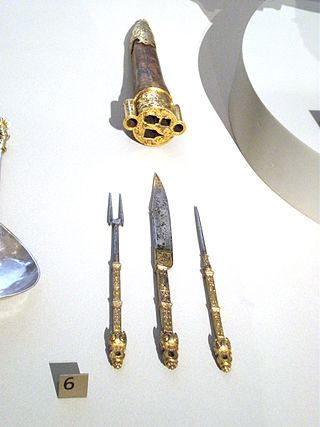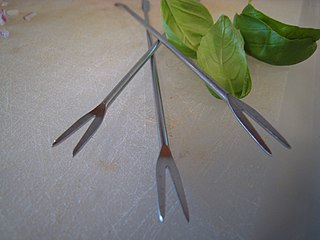
The fish knife together with fish fork represent a set of utensils specialized for eating fish. Fish knife is a strange-looking, purposedly blunt implement. [1]

The fish knife together with fish fork represent a set of utensils specialized for eating fish. Fish knife is a strange-looking, purposedly blunt implement. [1]

Fish knives, like most highly specialized utensils, date back to Victorian era. The fish knife was preceded in the 18th century by a silver fish slice (also known as fish trowel, fish carver, and fish knife [2] ), [1] a broad tool used for serving fish (thus yet another name, fish server), pudding, [3] and other soft desserts . At the turn of the 19th century, the originally symmetric and broad blade of the serving fish knife evolved into a scimitar-like shape, with the knife often marketed as a matched set with a four-tine serving fork. [4]
Prior to the modern fish knife introduction in the 19th century, aristocracy ate fish with two dinner forks, one to separate a piece, another one to eat. The other approach used a single fork, with a slice of bread for assistance. [5] Use of the knife came from the rich commoners, with high society at first frowning upon it as a too specialized tool (and the one they were also missing in their hereditary silverware sets). [6]
Use of silver as a material for the knife was the only available mean (before the arrival of the stainless steel) to enable pairing of lemon and fish without encountering a metallic taste. [7]

The knife has a distinct shape that evolved from a fish server. The modern knives are about 8 to 9 inches long, have a dull blade and frequently a notch close to the sharp tip that can be used to separate the bones from the flesh of the fish. [6]
The fish knife is not designed for cutting. Since for fish no force is required for separating the flesh from the bones, the knife is supposed to be held between the thumb and two first fingers (like a pencil [8] ) and used to fillet the fish, lift the skeleton, and remove the small remaining bones. [9] If the fish is served already without bones, knife is used to "flake" the pieces onto the fork, its use can be avoided altogether ("American style"). [8]
Fish knives and forks were originally very expensive silverware items, allowing the well-to-do to use them as a class marker, status symbols that are used to indicate the user or owner's elite status. [7] After the invention of electroplating, knife and fork sets became more affordable by 1860s, but the possession of them still indicated belonging to the "comfortable" middle class. [1] By the middle of the 20th century the nice fish knife and fork sets became a symbol for upper-class aspirations of a household. John Betjeman starts his poem "How to get on in society" (1958) with a pursuit of fish knives as a symbol of pretensions (Phone for the fish knives ... I must have things daintily served). [10]
In the 21st century use of the fish knives at a restaurant is also a symbol of high aspirations (perhaps, for a Michelin star). [11]

A spoon is a utensil consisting of a shallow bowl, oval or round, at the end of a handle. A type of cutlery, especially as part of a place setting, it is used primarily for transferring food to the mouth. Spoons are also used in food preparation to measure, mix, stir and toss ingredients and for serving food. Present day spoons are made from metal, wood, porcelain or plastic. There are a wide variety of spoons that are made of a variety of materials and by different cultures for many different uses and foods.

In cutlery or kitchenware, a fork is a utensil, now usually made of metal, whose long handle terminates in a head that branches into several narrow and often slightly curved tines with which one can spear foods either to hold them to cut with a knife or to lift them to the mouth.

A blade is the portion of a tool, weapon, or machine with an edge that is designed to puncture, chop, slice or scrape surfaces or materials. Blades are typically made from materials that are harder than those they are to be used on. Historically, humans have made blades from flaking stones such as flint or obsidian, and from various metal such as copper, bronze, and iron. Modern blades are often made of steel or ceramic. Blades are one of humanity's oldest tools, and continue to be used for combat, food preparation, and other purposes.

Cutlery, includes any hand implement used in preparing, serving, and especially eating food in Western culture. A person who makes or sells cutlery is called a cutler. The city of Sheffield in England has been famous for the production of cutlery since the 17th century and a train – the Master Cutler – running from Sheffield to London was named after the industry. Bringing affordable cutlery to the masses, stainless steel was developed in Sheffield in the early 20th century.

Table setting or place setting refers to the way to set a table with tableware—such as eating utensils and for serving and eating. The arrangement for a single diner is called a place setting. It is also the layout in which the utensils and ornaments are positioned. The practice of dictating the precise arrangement of tableware has varied across cultures and historical periods.

Nakiri bōchō and usuba bōchō are Japanese-style vegetable knives. They differ from the deba bōchō in their shape, as they have a straight blade edge suitable for cutting all the way to the cutting board without the need for a horizontal pull or push. These knives are also much thinner. While the deba bōchō is a heavy blade for easy cutting through thin bones, the blade is not suitable for chopping vegetables, as the thicker blade can break the vegetable slice. The nakiri bōchō and the usuba bōchō have a much thinner blade. This does not help with cutting small bones in fish or meat, but is useful for cutting vegetables.
Sashimi bōchō, literally "sashimi knife" is a type of long, thin knife used in Japanese cuisine to prepare sashimi. Types of sashimi bōchō include tako hiki, yanagi ba, and fugu hiki.

Various customary etiquette practices exist regarding the placement and use of eating utensils in social settings. These practices vary from culture to culture. Fork etiquette, for example, differs in Europe, the United States, and Southeast Asia, and continues to change. In East Asian cultures, a variety of etiquette practices govern the use of chopsticks.

Kitchenware are the tools, utensils, appliances, dishes, and cookware used in food preparation, or the serving of food. Kitchenware can also be used in order to hold or store food before or after preparation.

Tableware items are the dishware and utensils used for setting a table, serving food, and dining. The term includes cutlery, glassware, serving dishes, serving utensils, and other items used for practical as well as decorative purposes. The quality, nature, variety and number of objects varies according to culture, religion, number of diners, cuisine and occasion. For example, Middle Eastern, Indian or Polynesian food culture and cuisine sometimes limits tableware to serving dishes, using bread or leaves as individual plates, and not infrequently without use of cutlery. Special occasions are usually reflected in higher quality tableware.

A kitchen knife is any knife that is intended to be used in food preparation. While much of this work can be accomplished with a few general-purpose knives – notably a large chef's knife, a tough cleaver, a small paring knife and some sort of serrated blade – there are also many specialized knives that are designed for specific tasks. Kitchen knives can be made from several different materials.

Table manners are the rules of etiquette used while eating, which may also include the use of utensils. Different cultures observe different rules for table manners. Each family or group sets its own standards for how strictly these rules are to be followed.

A cheese knife is a type of kitchen knife specialized for the cutting of cheese. Different cheeses require different knives, according primarily to hardness. There are also a number of other kitchen tools designed for cutting or slicing cheese, especially the harder types. These include the cheese cutter, cheese slicer, cheese plane, cheese scoop for soft cheese and others, collectively known as cheese servers.

A fish slice is a kitchen utensil with a wide, flat blade with holes in it, used for lifting and turning food while cooking. It may be called a slotted spatula or a turner or flipper. The utensil was originally designed as a serving piece rather than a cooking implement.

A lobster pick or lobster fork is a long, narrow food utensil used to extract meat from joints, legs, claws, and other small parts of a lobster. Lobster picks are usually made of stainless steel and weigh as much as an average teaspoon. They have a long, textured cylindrical handle, ending in a crescent-shaped moderately sharp pick, or else a small two-tined fork. A three-tined version has a longer central tine with two shorter side tines with hooks on them. The other end may have a spoon for scooping out meat from inside the lobster. The lobster pick can also be used with other seafood, such as crab and crawfish.

The sugar tongs are small serving utensils used at the table to transfer sugar pieces from the sugar bowl to the tea cups. The tongs appeared at the end of the 17th century, and were very popular by 1800, with half of the British households owning them. The decline of the formal tea party led to the disappearance of the sugar tongs, in the 21st century they are considered an oddity at the table in their original role, but had acquired a new meaning: the tongs now represent Englishness. Also, these tongs still can be used to serve small candy, string beans, slices of cucumber, celery sticks.
The lemon fork is a small serving utensil that is used to move lemon slices. Lemon forks have three long tines, with the outside tines splayed; ostensibly this arrangement helps to release more juice. Lemon forks became popular in the last quarter of the 19th century alongside other specialized utensils, such as asparagus tongs. One early 20th century cookbook called the lemon fork a "necessity" at the five-o-clock tea party. At table settings, the fork was placed over the slice of lemon. Unlike many specialized utensils, lemon forks are still used in the 21st century, primarily in the restaurants.

The fish fork, sometimes along with the fish knife, is an eating utensil specialized for fish meals. Like most highly specialized utensils, the fork dates back to Victorian era. With the length of about 7.5 inches, the distinctive features might include a wide left tine or a deep notch that can be fit over the bones. To avoid the chemical reaction with the acidic lemon and associated metallic taste, the fork was traditionally, until the arrival of stainless steel in the 1920s, made of silver.

Combination eating utensils, also known as hybrid utensils, are utensils that have the qualities of other utensils combined into one. This can be done to make a more convenient, less wasteful, or more cost-efficient product. Many different types of combination utensils have been created, each designed to serve a different purpose.